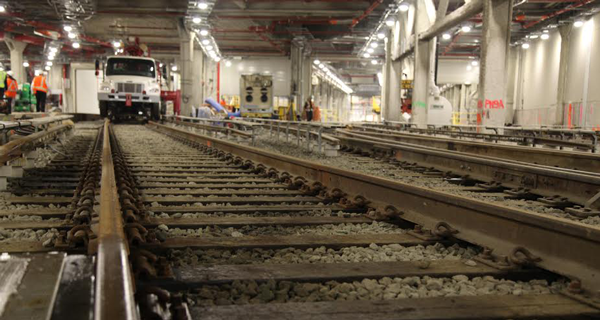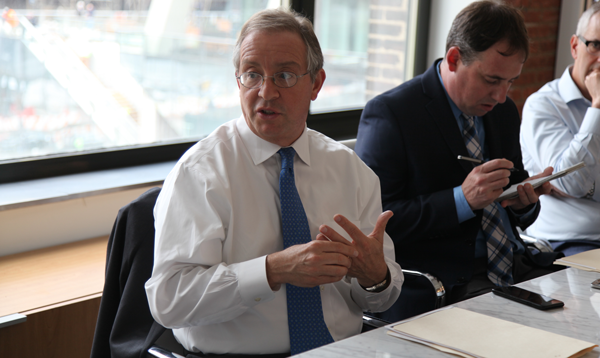Trending
Amtrak Chairman Anthony Coscia: NYC real estate depends on Gateway
Penn Station is in trouble — and so is the property biz if nothing gives

When tracks are pushing 100 years old, even minor derailments can play havoc with commuters’ lives for days (or longer). After two derailments at Penn Station already this year, AMTRAK announced on Thursday that it will close down several tracks this summer for major repairs.
The future disruption highlights a harder truth: In order to complete all the repairs and updates the tracks need, Amtrak would have to completely shut down the tunnel. Without a replacement link under the Hudson River at the ready, that’s not an option.
“If we took that tunnel out of service completely, for any amount of time — a month, two months, three months — it would be a community Armageddon that I can’t even begin to describe,” said Anthony Coscia, chairman of Amtrak’s board. “I’m not at all upset about commuters who are upset. They should be upset.”
Coscia sat down with The Real Deal on Thursday to discuss what’s planned for Penn Station this summer, the need for the long-delayed Gateway tunnel project to move forward, and what’s at stake for New York City real estate.

Tracks inside the LIRR storage facility in Hudson Yards (Credit: Alistair Gardiner for The Real Deal)
Gateway, a $20 billion proposal to expand the rail line between Newark and New York City, does not yet have funding, and the Trump administration has not indicated that it will move to OK an Obama-era approval for the project to move forward. No matter how many private partners the Gateway Development Corporation finds for the project, it won’t get done without a significant amount of public subsidy, Coscia said. And if it doesn’t get done, New York real estate will pay dearly.
“Gateway and the way we manage all of this will play a major role in whether you can sustain real estate values in and around New York City,” he said. “What’s the value of a building, whether it’s commercial office space, residential, retail, if you can’t generate access to it?”
As for Amtrak’s business beyond the rails, Coscia points to real estate deals as a key component for the company’s long-term health. Amtrak holds numerous real estate assets all over the country that the company’s owned for decades. These assets are already bringing in more than $100 million annually, Coscia said, but there’s potential for major real estate development in several of these locations and Amtrak has issued RFPs or begun negotiations with developers in several U.S. cities. That includes a deal to redevelop the Farley Post Office near Penn Station, which Vornado Realty Trust and Related Companies were tapped to take on last year. The new Amtrak train hall is expected to be completed by 2020.
“We own some pretty big pieces of real estate in some interesting places, but these aren’t greenfield developments. These are developments that in order to really get your handle around the density …it’s going to take some work, but we’re well on our way toward it,” Coscia said.
But political realities have made wins difficult for the America’s largest passenger rail service. It’s long been a favorite punching bag for local politicians, like New Jersey Gov. Chris Christie, who infamously axed the Access to the Region’s Core project in 2010, and outright blamed Amtrak for the recent derailments, ordering New Jersey Transit to withhold funds to the transit company. (He indicated on Thursday that he was pleased with Amtrak’s repair plans.)
During a stop in Long Island on Wednesday, Gov. Andrew Cuomo also made a point to bash Amtrak.
“I have lost all patience with Amtrak,” he told reporters. “Fix it. Do your job.”

Anthony Coscia (Credit: Alistair Gardiner for The Real Deal)
Some politicians tend to see Amtrak as merely a poorly-managed pit into which funds are diverted and then simply disappear — President Ronald Reagan once called it a “mobile federal money-burning machine.” In 2013, then-Florida Congressman John Mica, who wanted to privatize Amtrak, called it a “a monopoly run in a Soviet-style operation.”
“The reality is that we have a very very difficult task of trying to hold together infrastructure that in some cases was built over 100 years ago, and we are not deeply flush with capital to invest in that system,” Coscia said.
Infrastructure spending in the United States as a share of gross domestic product in recent years has hovered around 2.5 percent, far below the 3.9 percent in states such as Canada, Australia and South Korea, according to the McKinsey Global Institute report. Several European nations devote between 9 and 12 percent to infrastructure, and global rival China spends more on infrastructure than the U.S. and Europe combined.
For Fiscal Year 2017, Amtrak sought $1.8 billion in funding. It received $1.4 billion from Congress.
As for Gateway, which would require federal funding, the Trump administration has so far failed to indicate whether it will support public spending as a part of the largely private-sector generated, $1 trillion infrastructure package it wants Congress to send to his desk.
A Trump transition team memo leaked just after the inauguration, however, listed Gateway number one on a 50-project list of infrastructure priorities. Coscia said it’s going to take both private capital and public subsidies to get Gateway done.
“There’s no way that this should be done without private capital and there’s no way it can be done without public capital,” he said.




